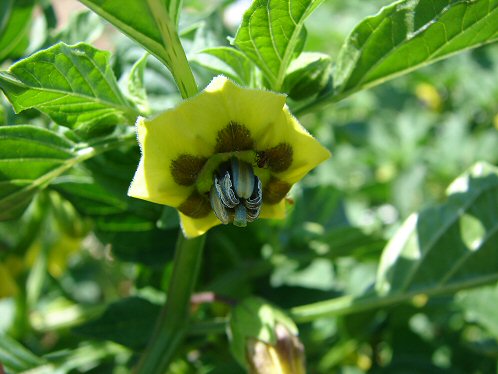Arizona Vegetable & Fruit Gardening
For The Arizona Desert Environment.
Pictures, Photos, Images
Descriptions
Information, & Reviews.
| Tomatillo, Physalis philadelphica. Plant. Purple Variety. - Photo Taken July 02, 2011 In Yarnell, Arizona. At Yarnell Community Garden. In A Raised Bed. Organically Grown. |
|---|
| Tomatillo, Physalis philadelphica. Flower. Organically Grown. | Tomatillo, Physalis philadelphica. Flower. Organically Grown. |
|---|---|
 | |
| Tomatillo, Physalis philadelphica. Flower. Organically Grown. | Tomatillo, Physalis philadelphica. Flower. Organically Grown. |
| Tomatillo, Physalis philadelphica. Fruit. Organically Grown. | Tomatillo, Physalis philadelphica. Fruit. Organically Grown. |
| Tomatillo, Physalis philadelphica. Fruit. Organically Grown. | Tomatillo, Physalis philadelphica. Leaf. Organically Grown. |
| Ripe Tomatillo, Physalis philadelphica. Fruit. Purple Variety. Organically Grown. | Ripe Tomatillo, Physalis philadelphica. Fruit. Purple Variety. Organically Grown. |
| Plants. Tomatillo, Physalis philadelphica. Organically Grown In A Raised Bed. | Plants. Tomatillo, Physalis philadelphica. Organically Grown In A Raised Bed. |
Tomatillo
The tomatillo (Physalis philadelphica) or (Physalis ixocarpa) is a plant of the nightshade family, related to the cape gooseberry, bearing small, spherical and green or green-purple fruit of the same name. Tomatillos, referred to as green tomato (Spanish: tomate verde) in Mexico, are a staple in Mexican cuisine. They are usually blanched to roasted, though they can be eaten raw in salads, and are an essential ingredient for green moles, salsas and green chili sauce. Their pulp develops a glutinous consistency when cooked but maintains a pleasing sweet flavor. Tomatillos are thought to be native of Mexico, the Caribbean, Central America, Chile, & the Peru Highlands. This bushy, heat-loving annual is believed to have been cultivated as early as pre-Columbian times. Tomatillos, are dicots, and are grown as annual herbs throughout the Western Hemisphere. Often self-incompatible, tomatillos often need a second plant to enhance pollination and guarantee fruit set. Grow tomatillos as you would tomatoes: Grow tomatillos in full hot sun and average soil with good drainage after danger of spring frost has passed. Like all garden plants, they require regular irrigation until well-established. You may need to cage or stake your plants to keep the fruit off the ground The 2- to 3-inch diameter tomatillo fruit is surrounded by an inedible, paper-like husk formed from the calyx. As the fruit matures, it fills the husk and can split it open by harvest. The husk turns brown, and the fruit can be any of a number of colors when ripe, including yellow, red, green, or even purple. Remove fruits from the plant when husks turn tan and split open and the fruits inside are firm. Tomatillos are the key ingredient in fresh and cooked Latin American green sauces. Fruit should be firm and bright green, as the green color and tart flavor are the main culinary contributions of the fruit. Purple and red-ripening cultivars often have a slight sweetness, unlike the green- and yellow-ripening cultivars, and are therefore somewhat more suitable for fruit-like uses like jams and preserves. Like their close relatives cape gooseberries, tomatillos have a high pectin content. Avoid planting them near black walnut trees as they are very sensitive to the tree�s root toxin, juglone. Be sure to gather all fruits from the ground in fall because they will self-sow with vigor if given the chance. Collect them frequently because ripe tomatillos can drop to the ground and rot. Ripe tomatillos will keep in the refrigerator for about two weeks. They will keep even longer if the husks are removed and the fruits are placed in sealed plastic bags stored in the refrigerator. They may also be frozen whole or sliced. Tomatillos require 55 to 75 harvest days, if growing conditions are favorable. Like tomatoes, tomatillos require substantial heat for good fruit production. After they begin to produce fruit, they will continue for as long as four months�if nights and days remain substantially warm. When temperatures drop below 41 degrees Fahrenheit, chilling damage will occur and the fruits will become watery and lose sweetness. If frost is expected, remove the entire plant and hang it upside down in a sheltered location to ripen the remaining fruits. Like tomatoes, they will continue to ripen after harvest.
PLANTING TOMATILLO:
We recommend using raised bed gardens. 1. Dig garden soil at least 6 - 8 inches deep. 2. Lightly amend heavy clay or sandy soils with organic matter. 3. Sow seed directly into garden soil, with large seed planted more deeply than small seed. 4. Or gently remove plants from containers, loosen potting soil and roots, and plant level with surrounding soil, spreading roots outward. 5. Fill around roots with lightly amended soil. 6. Water to settle soil around roots. 7. Water deeply. 8. Stake large vine-type vegetables such as tomatillos to help them grow upward instead of sprawling on the ground.
Type: Considered a vegetable. But a Berry (true).
|
Sold Through Amazon.Com That We Recommend!
Click On The Item For A More Detailed Look. No Obligation!



Here Are Some Links To The Very Best & Most Popular Items Sold On Amazon.Com
To Learn More! Click The Links Below. No Obligation, Of Course!
|
|
|---|
| Back To Arizona Vegetable & Fruit Gardening
|
| Back To Arizona Xeriscape Landscaping Main Page
|
| To Arizona Wild Flowers Home Page
|
| Back To DeLange Home Page
Images And Text Copyright Eve & George DeLange.
|


